Driving commercial and political engagement between Asia, the Middle East and Europe
Driving commercial and political engagement between Asia, the Middle East and Europe
Driving commercial and political engagement between Asia, the Middle East and Europe
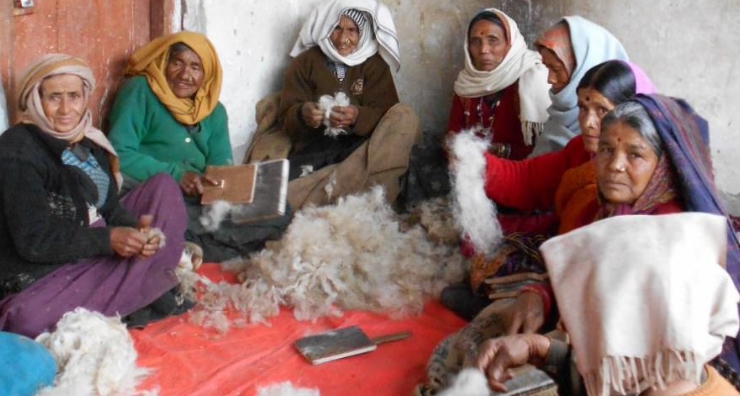
An exhibition showcasing beautiful woollen and cashmere products made by village women living in the Himalayas who were affected by the 2013 Uttarkhand floods took place at Asia House from 25-29 November, 2014.
The Mandikini Women Weavers of Garhwal was registered as a society in India in January 2014 after the women living in the flood-ravaged region in the northern Indian state started to receive training in knitting and weaving from another group of village women 200km away who were running their own weaving collective and wanted to help them.
Asia House hosted the first ever sale of woollen and cashmere blankets, scarves, hats and shawls hand-woven and spun by these women flood survivors.
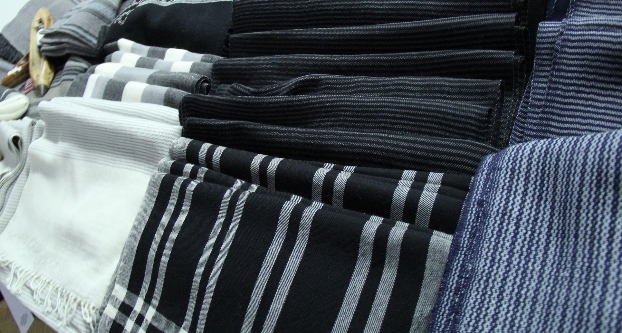
Some of the scarves made by the Mandikini Women Weavers of Garhwal
Mukti Datta, who lives on a beautiful estate, formerly owned by the British commissioner pre-Independence, 200km away from the flood affected region in the Almora district in the Kumaon Province in Uttarkhand, said many charities had sent food packages, blankets and water to the affected region, but a few months down the line locals needed more than that – they needed buildings, roads, infrastructure and a livelihood. Training these women was also a way to help them come out of their trauma of losing husbands, sons and other male relatives, she said.
“About half the women in the Mandikini Women Weavers are from the Brahmin caste. Many of them had husbands working as priests at the Kedarnath Temple who died immediately. The rest are mixed castes, whose husbands, sons and brothers were the chai and shop wallahs, running hotels, restaurants and businesses around the temple and providing other services to the pilgrims, all of which were destroyed,” she said. These women had relied on husbands or male relatives for an income, she explained.
Between 5,000 and 30,000 people lost their lives in the floods that ravaged the mountainous region when unseasonal torrential rains fell causing the Mandikini River to burst its banks unleashing havoc in the Kedarnath valley. The ensuing landslides and flash floods left thousands dead and obliterated schools, hospitals and other buildings.
More than 100,000 people had to be rescued by the Indian military. But the 8th century Kedarnath Temple dedicated to Shiva, the Hindu god of destruction, remained intact.
Although the women received compensation from the state government, the money would often end up in the wrong hands as the male relative’s family would often fight over it and the women did not have bank accounts, she said.
“It was mainly the businesses, small shops and restaurants around the temple that were destroyed. Decomposed bodies were found for months afterwards. Some of the women were so traumatised that they would not come out of their homes,” she said.
“They see the floods as retribution for all the evil perpetrated by the tourists and priests for taking too much money, as well as for the construction and all the excess in the area near the temple making it like a picnic spot and not a holy place. Everyone there believes that Shiva, the Lord of Destruction, who the Kedarnath Temple is dedicated to, just wanted to be left alone,” she said.
“The floods took place 200km from where we live but all of us were affected at an emotional level – up to 30,000 were killed and villages were wiped away. The devastation was horrendous,” Datta explained over a cup of tea in Mackwoods Tea Room.
In 1997 Datta had founded the Panchachuli Women Weavers of Kumaon co-operative, named after a group of five snow-capped sacred Himalayan peaks on the border between India and Tibet. It is this cooperative, based in Almora, where she lives, in a different region of Uttarkhand, which is training these Indian widows and other village women affected by the 2013 Uttarkhand floods 200km away to weave woollen products to lift them out of poverty and empower them.
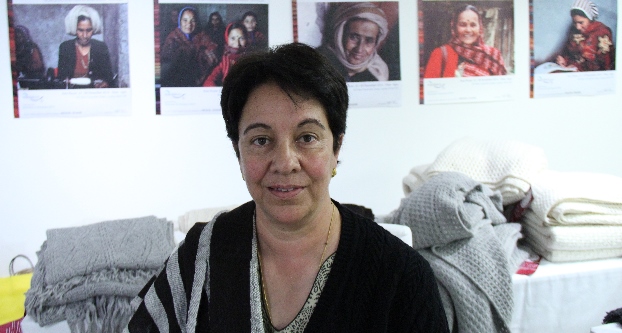
Mukti Datta pictured at the exhibition currently taking place at Asia House, where the Mandikini Women Weavers’ products are on sale
Mukti Datta’s interest in social issues began in her 20s when she wrote to the then prime minister Rajiv Gandhi about poaching and the timber mafia destroying the forests and wildlife in the picturesque Kumaon region of Eastern Uttarkhand.
Her campaign led to the reforestation of the Himalayan forest near her home in Almora and the establishment of the Binsar Wildlife Sanctuary.
“The problem was that even though we had done that, the Himalayan village women remained dependent on the forest for cutting trees and gathering fodder from the forest for animal husbandry and fuel,” Datta explained. “The forests remained encroached upon. These women have a life of drudgery and live in very male-dominated societies. So I came up with the idea of Panchachuli to ease the pressure of the forest and on these women, to also give them a livelihood and empower them,” she said.
The funds for Panchachuli were provided by a close friend of Datta’s, Dena Kaye, the daughter of the late Danny Kaye, a Hollywood film star and comedian, who donated cash from the Danny Kaye and Sylvia Fine Kaye Foundation, of which she is president. This was used to train 500 women in the Kumaon Province of Uttarakhand, in weaving and spinning.
The money paid for the raw materials, handlooms, carding machines (imported from Bradford), production centres and training. Datta helps with the designs. She explained she “had a taste for the colours of the European market” as she was half Belgian and half Indian. Her mother, a Belgian musicologist, had gone to Kumaon in the 1950s to record folk music and met her Punjabi father there.
The Panchachuli products are made using local merino sheep wool; local goat, camel, and lambswool; cashmere wool from Tibet; Alpaca wool from Peru; and lambswool from New Zealand; dyed in blues, browns, greys and blacks, to suit the tastes and fashions of Westerners.
Datta travels every August across the 19,000 feet high Himalayan mountains past Mount Kailash and Lake Manasarovar, accompanied by 50 ponies to buy the cashmere wool (made from the undercoat of goats that live in the cold desserts of Tibet and Mongolia) from Tibetan nomads.
“We have trade permits to enter Tibet. We go to these huge trade fairs where we meet nomads from western Tibet and traders from Xinjiang,” she explained, sipping tea.
Five to six tonnes of this raw wool is carried on the backs of ponies to India. Datta and her group camp all the way through the three-week journey.
Ten years after being formed Panchachuli became self-sufficient. Five hundred women, aged 20 to 60, remain in the co-operative which has three production units where they straighten, card and weave the wool. They are transported by bus each day from their villages sprinkled across Kumaon to their units and earn Rs 5,000 to Rs 7,000 a month. “It’s our own brand – we do not sell the products to any other brand but we do sell textiles to buyers. We have our own shops in the hills, otherwise we do exhibitions in Delhi and overseas,” Datta explained.
“It is now a not for profit company run by the women so all the profits are ploughed back into the company. The idea is to alleviate poverty,” she said.
“Every year at Diwali the Panchachuli women get a month’s bonus so in 2013 the women all said they wanted to donate their bonuses to the widows of Kedarnath, many of whom lost husbands or sons in the floods,” she said.
“Then the Panchachuli women had their AGM and then they decided it was better to help these women become self-sufficient and earn a livelihood than just donate a bonus,” she said.
“The Panchachuli women could all identify with these women as they were all rural village women like them. So 300 of them got together and travelled the 200km there to train them, ” she said. “The women worked in awful conditions in the winter and snow with no roads, no water and no electricity, as a result of the floods – but they hung in there and by March people started noticing and we got support from the American Indian Foundation towards administration and exhibitions like the one at Asia House and the Uttarakhand Government is now funding the equipment and infrastructure,” she said.

The Mandikini Women Weavers learn how to weave on handlooms using spun yarn
“Now we are scaling up as a result of the Uttarkhand Government deciding to partner with us so we plan to increase our presence in the remote Himalayan region. And we would like to repeat this event at Asia House next year,” she said.
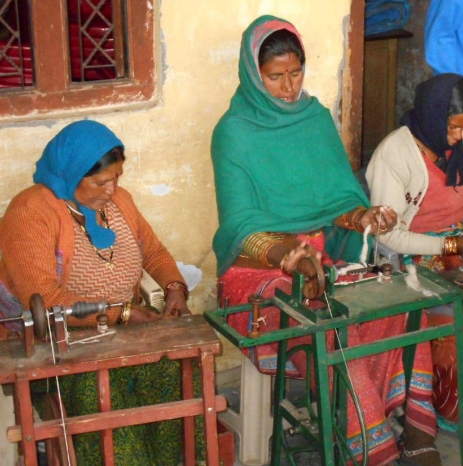
The Mandikini Women Weavers learn to spin fine yarn on traditional bageshwari charkha
“These women are just a year into their training. They need another year before they can become fully independent. At Asia House we are selling all the products from Mandikini and a few from Panchachuli. They were all hand-spun by the women of Mandikini but some were finished by the Panchachuli cooperative,” she explained.
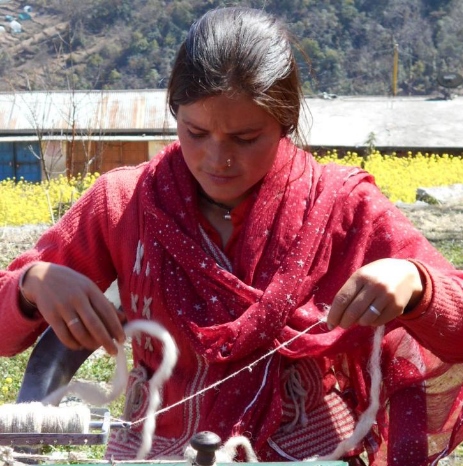
A woman from the Mandikini Women Weavers of Garhwal learns to spin fine yearn on a charkha
The Mandikini products have all been designed by the famous and popular Indian fashion designer duo Abraham & Thakore.
The exhibition at Asia House, which took place from 25-29 November, is the first time the products have been sold anywhere in the world, though they will be sold in India from December.
“It means these are like designer products. After Asia House we hope to exhibit them in Sydney and Colorado.”
The lambswool, Alpaca, sheepswool and cashmere scarves, blankets and knitted hats range from £20 to £250. Each one has the name of the person who wove it and their village on a label.
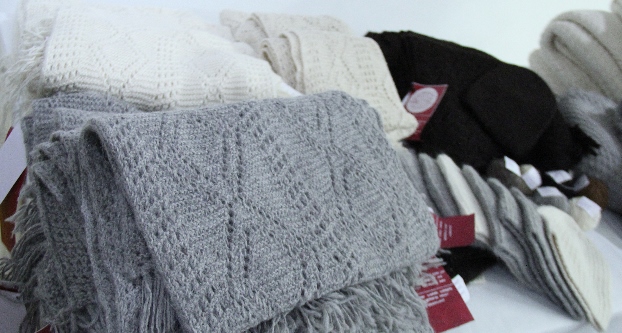
Some of the unisex woolen products made by the Mandikini Weavers that are on sale at Asia House
Many people died in the floods and others died of starvation in the jungle. Now the roads have been rebuilt and electricity restored but the businesses have not been rebuilt.
“The women were very depressed when we first arrived, but being part of the collective and using their hands was very therapeutic for them and they are much happier now,” Datta explained.
naomi.canton@asiahouse.co.uk
For more information about the exhibition click here. The Mandikini Women Weavers of Garhwal products were on sale in the Studio at Asia House from 25-29 November.

An exhibition showcasing beautiful woollen and cashmere products made by village women living in the Himalayas who were affected by the 2013 Uttarkhand floods took place at Asia House from 25-29 November, 2014.
The Mandikini Women Weavers of Garhwal was registered as a society in India in January 2014 after the women living in the flood-ravaged region in the northern Indian state started to receive training in knitting and weaving from another group of village women 200km away who were running their own weaving collective and wanted to help them.
Asia House hosted the first ever sale of woollen and cashmere blankets, scarves, hats and shawls hand-woven and spun by these women flood survivors.

Some of the scarves made by the Mandikini Women Weavers of Garhwal
Mukti Datta, who lives on a beautiful estate, formerly owned by the British commissioner pre-Independence, 200km away from the flood affected region in the Almora district in the Kumaon Province in Uttarkhand, said many charities had sent food packages, blankets and water to the affected region, but a few months down the line locals needed more than that – they needed buildings, roads, infrastructure and a livelihood. Training these women was also a way to help them come out of their trauma of losing husbands, sons and other male relatives, she said.
“About half the women in the Mandikini Women Weavers are from the Brahmin caste. Many of them had husbands working as priests at the Kedarnath Temple who died immediately. The rest are mixed castes, whose husbands, sons and brothers were the chai and shop wallahs, running hotels, restaurants and businesses around the temple and providing other services to the pilgrims, all of which were destroyed,” she said. These women had relied on husbands or male relatives for an income, she explained.
Between 5,000 and 30,000 people lost their lives in the floods that ravaged the mountainous region when unseasonal torrential rains fell causing the Mandikini River to burst its banks unleashing havoc in the Kedarnath valley. The ensuing landslides and flash floods left thousands dead and obliterated schools, hospitals and other buildings.
More than 100,000 people had to be rescued by the Indian military. But the 8th century Kedarnath Temple dedicated to Shiva, the Hindu god of destruction, remained intact.
Although the women received compensation from the state government, the money would often end up in the wrong hands as the male relative’s family would often fight over it and the women did not have bank accounts, she said.
“It was mainly the businesses, small shops and restaurants around the temple that were destroyed. Decomposed bodies were found for months afterwards. Some of the women were so traumatised that they would not come out of their homes,” she said.
“They see the floods as retribution for all the evil perpetrated by the tourists and priests for taking too much money, as well as for the construction and all the excess in the area near the temple making it like a picnic spot and not a holy place. Everyone there believes that Shiva, the Lord of Destruction, who the Kedarnath Temple is dedicated to, just wanted to be left alone,” she said.
“The floods took place 200km from where we live but all of us were affected at an emotional level – up to 30,000 were killed and villages were wiped away. The devastation was horrendous,” Datta explained over a cup of tea in Mackwoods Tea Room.
In 1997 Datta had founded the Panchachuli Women Weavers of Kumaon co-operative, named after a group of five snow-capped sacred Himalayan peaks on the border between India and Tibet. It is this cooperative, based in Almora, where she lives, in a different region of Uttarkhand, which is training these Indian widows and other village women affected by the 2013 Uttarkhand floods 200km away to weave woollen products to lift them out of poverty and empower them.

Mukti Datta pictured at the exhibition currently taking place at Asia House, where the Mandikini Women Weavers’ products are on sale
Mukti Datta’s interest in social issues began in her 20s when she wrote to the then prime minister Rajiv Gandhi about poaching and the timber mafia destroying the forests and wildlife in the picturesque Kumaon region of Eastern Uttarkhand.
Her campaign led to the reforestation of the Himalayan forest near her home in Almora and the establishment of the Binsar Wildlife Sanctuary.
“The problem was that even though we had done that, the Himalayan village women remained dependent on the forest for cutting trees and gathering fodder from the forest for animal husbandry and fuel,” Datta explained. “The forests remained encroached upon. These women have a life of drudgery and live in very male-dominated societies. So I came up with the idea of Panchachuli to ease the pressure of the forest and on these women, to also give them a livelihood and empower them,” she said.
The funds for Panchachuli were provided by a close friend of Datta’s, Dena Kaye, the daughter of the late Danny Kaye, a Hollywood film star and comedian, who donated cash from the Danny Kaye and Sylvia Fine Kaye Foundation, of which she is president. This was used to train 500 women in the Kumaon Province of Uttarakhand, in weaving and spinning.
The money paid for the raw materials, handlooms, carding machines (imported from Bradford), production centres and training. Datta helps with the designs. She explained she “had a taste for the colours of the European market” as she was half Belgian and half Indian. Her mother, a Belgian musicologist, had gone to Kumaon in the 1950s to record folk music and met her Punjabi father there.
The Panchachuli products are made using local merino sheep wool; local goat, camel, and lambswool; cashmere wool from Tibet; Alpaca wool from Peru; and lambswool from New Zealand; dyed in blues, browns, greys and blacks, to suit the tastes and fashions of Westerners.
Datta travels every August across the 19,000 feet high Himalayan mountains past Mount Kailash and Lake Manasarovar, accompanied by 50 ponies to buy the cashmere wool (made from the undercoat of goats that live in the cold desserts of Tibet and Mongolia) from Tibetan nomads.
“We have trade permits to enter Tibet. We go to these huge trade fairs where we meet nomads from western Tibet and traders from Xinjiang,” she explained, sipping tea.
Five to six tonnes of this raw wool is carried on the backs of ponies to India. Datta and her group camp all the way through the three-week journey.
Ten years after being formed Panchachuli became self-sufficient. Five hundred women, aged 20 to 60, remain in the co-operative which has three production units where they straighten, card and weave the wool. They are transported by bus each day from their villages sprinkled across Kumaon to their units and earn Rs 5,000 to Rs 7,000 a month. “It’s our own brand – we do not sell the products to any other brand but we do sell textiles to buyers. We have our own shops in the hills, otherwise we do exhibitions in Delhi and overseas,” Datta explained.
“It is now a not for profit company run by the women so all the profits are ploughed back into the company. The idea is to alleviate poverty,” she said.
“Every year at Diwali the Panchachuli women get a month’s bonus so in 2013 the women all said they wanted to donate their bonuses to the widows of Kedarnath, many of whom lost husbands or sons in the floods,” she said.
“Then the Panchachuli women had their AGM and then they decided it was better to help these women become self-sufficient and earn a livelihood than just donate a bonus,” she said.
“The Panchachuli women could all identify with these women as they were all rural village women like them. So 300 of them got together and travelled the 200km there to train them, ” she said. “The women worked in awful conditions in the winter and snow with no roads, no water and no electricity, as a result of the floods – but they hung in there and by March people started noticing and we got support from the American Indian Foundation towards administration and exhibitions like the one at Asia House and the Uttarakhand Government is now funding the equipment and infrastructure,” she said.

The Mandikini Women Weavers learn how to weave on handlooms using spun yarn
“Now we are scaling up as a result of the Uttarkhand Government deciding to partner with us so we plan to increase our presence in the remote Himalayan region. And we would like to repeat this event at Asia House next year,” she said.

The Mandikini Women Weavers learn to spin fine yarn on traditional bageshwari charkha
“These women are just a year into their training. They need another year before they can become fully independent. At Asia House we are selling all the products from Mandikini and a few from Panchachuli. They were all hand-spun by the women of Mandikini but some were finished by the Panchachuli cooperative,” she explained.

A woman from the Mandikini Women Weavers of Garhwal learns to spin fine yearn on a charkha
The Mandikini products have all been designed by the famous and popular Indian fashion designer duo Abraham & Thakore.
The exhibition at Asia House, which took place from 25-29 November, is the first time the products have been sold anywhere in the world, though they will be sold in India from December.
“It means these are like designer products. After Asia House we hope to exhibit them in Sydney and Colorado.”
The lambswool, Alpaca, sheepswool and cashmere scarves, blankets and knitted hats range from £20 to £250. Each one has the name of the person who wove it and their village on a label.

Some of the unisex woolen products made by the Mandikini Weavers that are on sale at Asia House
Many people died in the floods and others died of starvation in the jungle. Now the roads have been rebuilt and electricity restored but the businesses have not been rebuilt.
“The women were very depressed when we first arrived, but being part of the collective and using their hands was very therapeutic for them and they are much happier now,” Datta explained.
naomi.canton@asiahouse.co.uk
For more information about the exhibition click here. The Mandikini Women Weavers of Garhwal products were on sale in the Studio at Asia House from 25-29 November.
